Advertisements
Advertisements
प्रश्न
Consider a situation similar to that of the previous problem except that the ends of the rod slide on a pair of thick metallic rails laid parallel to the wire. At one end the rails are connected by resistor of resistance R. (a) What force is needed to keep the rod sliding at a constant speed v? (b) In this situation what is the current in the resistance R? (c) Find the rate of heat developed in the resistor. (d) Find the power delivered by the external agent exerting the force on the rod.
उत्तर
(a) Here, the magnetic field \[\overrightarrow B\] due to the long wire varies along the length of the rod.
We will consider a small element of the rod of length da at a distance a from the wire. The magnetic field at a distance a is given by
\[\overrightarrow{B} = \frac{\mu_0 i}{2\pi a}\]
Now,
Induced emf in the rod:-
\[de = Bvda\]
\[de = \frac{\mu_0 i}{2\pi a} \times v \times da\]
Integrating `x-l/2` and `x+l/2,` we get
\[e = \int\limits_{x - \frac{l}{2}}^{x + \frac{l}{2}} de\]
\[ = \int\limits_{x - \frac{l}{2}}^{x + \frac{l}{2}}\frac{\mu_0 i}{2\pi a} vda\]
\[ = \frac{\mu_0 iv}{2\pi}\left[ \ln\left( x + \frac{l}{2} \right) - \ln\left( x - \frac{l}{2} \right) \right]\]
\[ = \frac{\mu_0 iv}{2\pi}\ln\left[ \frac{x + \frac{l}{2}}{x - \frac{l}{2}} \right]\]
Emf induced in the rod due to the current-carrying wire:-
\[e = \frac{\mu_0 iv}{2\pi}\ln\left( \frac{2x + l}{2x - l} \right)\]
Now, let the current produced in the circuit containing the rod and the resistance be i'.
\[i' = \frac{e}{R}\]
\[ = \frac{\mu_0 iv}{2\pi R}\ln\left( \frac{2x + 1}{2x - 1} \right)\]
Force on the element:-
dF = i'Bl
\[\Rightarrow dF = \frac{\mu_0 iv}{2\pi R}\ln\left( \frac{2x + l}{2x - l} \right) \times \left( \frac{\mu_0 i}{2\pi a} \right) \times da\]
\[ = \left( \frac{\mu_0 i}{2\pi} \right)^2 \frac{v}{R}\ln\left( \frac{2x + l}{2x - l} \right)\frac{dx}{a}\]
And,
\[F = \left( \frac{\mu_0 i}{2\pi} \right)^2 \frac{v}{R}\ln\left( \frac{2x + l}{2x - l} \right) \int\limits_{x - \frac{l}{2}}^{x + \frac{l}{2}} \frac{da}{a}\]
\[ = \left( \frac{\mu_0 i}{2\pi} \right)^2 \frac{v}{R}\ln\left( \frac{2x + l}{2x - l} \right)\ln\left( \frac{2x + l}{2x - l} \right)\]
\[ = \frac{v}{R} \left[ \frac{\mu_0 i}{2\pi}\ln\left( \frac{2x + l}{2x - l} \right) \right]^2\]
(b) Current, \[i' = \frac{e}{R} = \frac{\mu_0 iv}{2\pi R}\ln\left( \frac{2x + l}{2x - l} \right)\]
(c) The rate of heat, that is, power, developed is given by
w = i2 R
\[w = \left[ \frac{\mu_0 iv}{2\pi R}\ln\left( \frac{2x + l}{2x - l} \right) \right]^2 R\]
\[ = \frac{1}{R} \left[ \frac{\mu_0 iv}{2\pi}\ln\left( \frac{2x + l}{2x - l} \right) \right]^2\]
(d) Power delivered by the external agency is the same as the rate of heat developed.
Here,
p = i2R
\[= \frac{1}{R} \left[ \frac{\mu_0 iv}{2\pi}\ln\left( \frac{2x + l}{2x - l} \right) \right]^2\]
APPEARS IN
संबंधित प्रश्न
Figure shows a metal rod PQ resting on the smooth rails AB and positioned between the poles of a permanent magnet. The rails, the rod, and the magnetic field are in three mutual perpendicular directions. A galvanometer G connects the rails through a switch K. Length of the rod = 15 cm, B = 0.50 T, resistance of the closed loop containing the rod = 9.0 mΩ. Assume the field to be uniform.
(a) Suppose K is open and the rod is moved with a speed of 12 cm s−1 in the direction shown. Give the polarity and magnitude of the induced emf.
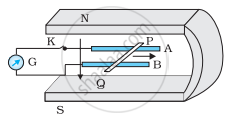
(b) Is there an excess charge built up at the ends of the rods when K is open? What if K is closed?
(c) With K open and the rod moving uniformly, there is no net force on the electrons in the rod PQ even though they do experience magnetic force due to the motion of the rod. Explain.
(d) What is the retarding force on the rod when K is closed?
(e) How much power is required (by an external agent) to keep the rod moving at the same speed = (12 cm s−1) when K is closed? How much power is required when K is open?
(f) How much power is dissipated as heat in the closed circuit? What is the source of this power?
(g) What is the induced emf in the moving rod if the magnetic field is parallel to the rails instead of being perpendicular?
A circular coil of radius 10 cm, 500 turns and resistance 200 Ω is placed with its plane perpendicular to the horizontal component of the Earth's magnetic field. It is rotated about its vertical diameter through 180° in 0.25 s. Estimate the magnitude of the emf and current induced in the coil. (Horizontal component of the Earth's magnetic field at the place is 3.0 ✕ 10−5 T).
State Lenz’s Law.
A metallic rod held horizontally along east-west direction, is allowed to fall under gravity. Will there be an emf induced at its ends? Justify your answer.
A metallic rod of length ‘l’ is rotated with a frequency v with one end hinged at the centre and the other end at the circumference of a circular metallic ring of radius r, about an axis passing through the centre and perpendicular to the plane of the ring. A constant uniform magnetic field B parallel to the axis is present everywhere. Using Lorentz force, explain how emf is induced between the centre and the metallic ring and hence obtained the expression for it.
Two circular loops are placed coaxially but separated by a distance. A battery is suddenly connected to one of the loops establishing a current in it. Will there be a current induced in the other loop? If yes, when does the current start and when does it end? Do the loops attract each other or do they repel?
Figure shows a conducting loop being pulled out of a magnetic field with a speed v. Which of the four plots shown in figure (b) may represent the power delivered by the pulling agent as a function of the speed v?
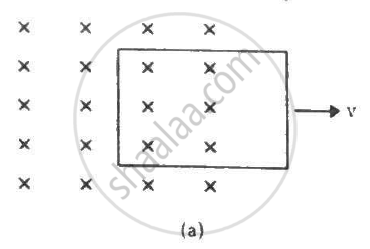

A rod AB moves with a uniform velocity v in a uniform magnetic field as shown in figure.
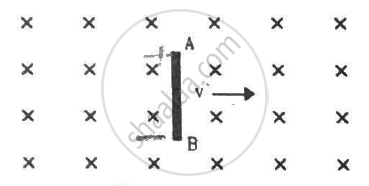
Suppose the resistance of the coil in the previous problem is 25Ω. Assume that the coil moves with uniform velocity during its removal and restoration. Find the thermal energy developed in the coil during (a) its removal, (b) its restoration and (c) its motion.
Figure shows a conducting square loop placed parallel to the pole-faces of a ring magnet. The pole-faces have an area of 1 cm2 each and the field between the poles is 0.10 T. The wires making the loop are all outside the magnetic field. If the magnet is removed in 1.0 s, what is the average emf induced in the loop?
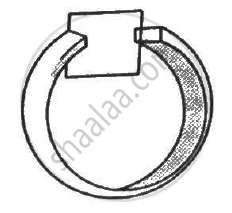
A uniform magnetic field B exists in a cylindrical region of radius 10 cm as shown in figure. A uniform wire of length 80 cm and resistance 4.0 Ω is bent into a square frame and is placed with one side along a diameter of the cylindrical region. If the magnetic field increases at a constant rate of 0.010 T/s, find the current induced in the frame.

A circular coil of radius 2.00 cm has 50 turns. A uniform magnetic field B = 0.200 T exists in the space in a direction parallel to the axis of the loop. The coil is now rotated about a diameter through an angle of 60.0°. The operation takes 0.100 s. (a) Find the average emf induced in the coil. (b) If the coil is a closed one (with the two ends joined together) and has a resistance of 4.00 Ω, calculate the net charge crossing a cross-section of the wire of the coil.
A copper wire bent in the shape of a semicircle of radius r translates in its plane with a constant velocity v. A uniform magnetic field B exists in the direction perpendicular to the plane of the wire. Find the emf induced between the ends of the wire if (a) the velocity is perpendicular to the diameter joining free ends, (b) the velocity is parallel to this diameter.
Figure shows a square loop of side 5 cm being moved towards right at a constant speed of 1 cm/s. The front edge enters the 20 cm wide magnetic field at t = 0. Find the total heat produced in the loop during the interval 0 to 30 s if the resistance of the loop is 4.5 mΩ.
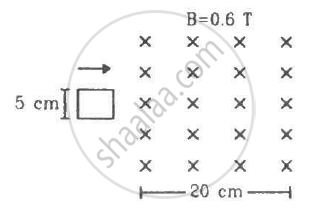
A conducting wire ab of length l, resistance r and mass m starts sliding at t = 0 down a smooth, vertical, thick pair of connected rails as shown in figure. A uniform magnetic field B exists in the space in a direction perpendicular to the plane of the rails. (a) Write the induced emf in the loop at an instant t when the speed of the wire is v. (b) What would be the magnitude and direction of the induced current in the wire? (c) Find the downward acceleration of the wire at this instant. (d) After sufficient time, the wire starts moving with a constant velocity. Find this velocity vm. (e) Find the velocity of the wire as a function of time. (f) Find the displacement of the wire as a function of time. (g) Show that the rate of heat developed in the wire is equal to the rate at which the gravitational potential energy is decreased after steady state is reached.

Plot a graph showing variation of induced e.m.f. with the rate of change of current flowing through a coil.
